Operation "Small Saturn". How they defeated the 8-th Italian army
The Wehrmacht used up forces intended to attack Stalingrad and refused further attempts to unblock the Paulus group surrounded there, which predetermined its fate and led to a radical change in the situation in the Stalingrad-Rostov sector (and on the entire Soviet-German front). The death of the Italian army on the Don caused literally shock in Rome. The relationship between Italy and Germany has deteriorated sharply. Rome actually ceased to be an ally of Germany. The Fascist regime of Mussolini's duce in Italy faltered.
Plans of the Soviet command
The preparation of a new offensive operation, renamed Saturn, began at the end of November 1942. The troops of the South-Western and Left Wing of the Voronezh Front in the course of this operation were to defeat the main forces of the 8 Italian army defending New Kalitva, Veshenskaya, and enemy troops on the r. Chir and in the area Tormosina, and then advance in the general direction of Millerovo, Rostov-on-Don. The South-Western Front was strengthened by new connections. December 8 The 1942 directive of the Stavka made up the 1-th Guards Army under the command of V. I. Kuznetsov (the third formation) from parts of the operational group of the South-Western Front.
On November 25, the representative of the Headquarters A. M. Vasilevsky, the commander of artillery of the Red Army N. N. Voronov, the commander of the Air Force A. A. Novikov together with the commander of the Voronezh Front F. I. Golikov began reconnaissance work in the XF sector of the HF 6 Army. The next day, the same work was done jointly with the commander of the Southwestern Front, NF Vatutin, on the right wing of this front.
To defeat the 8th Italian army and the German task force Hollidt, it was planned to create two strike groups on the South-Western Front: 1) on the right flank of the 1st Guards Army to launch a strike from the bridgehead south of Upper Mamon on Millerovo; 2) in the strip of the 3rd Guards Army D. D. Lelyushenko east of Bokovskaya to strike also at Millerovo, closing the encirclement. After that, the advancing troops were to advance to Rostov. The shock group of the Voronezh Front - the 6th Army under the command of F.M. Kharitonov was to strike from the area southwest of Upper Mamon to Kantemirovka, Voloshino. 5th tank P.L. Romanenko’s army was tasked with defeating the enemy at the junction of the Southwestern and Stalingrad fronts, in the area of Morozovsk, Tormosin, Chernyshevsky, and preventing his breakthrough to the encircled group. The actions of these troops were to be supported by the 17th Air Army.
The final version of the operation the command of the Southwestern and Voronezh fronts was to submit to 1942 in early December 21 Army of the Southwestern Front, 26 and 4 tank corps operating on the inner circle of the encirclement at Stalingrad, decided to transfer to Donskoy front. So that all the attention of the South-Western Front command was concentrated on the external line of the struggle and the preparation of Operation Saturn. The 2-I Guards Army of R. Ya. Malinovsky was transferred to the Stalingrad area. The Soviet Stavka initially planned to use the 2 th Guards Army as part of the forces of the South-Western Front to develop an offensive from the Kalach area in the direction of Rostov - Taganrog. However, in connection with the beginning of the offensive of the German army group "Got" in order to save the Stalingrad Paulus group, the army of Malinovsky was thrown into the fight against the German forces that were breaking through.
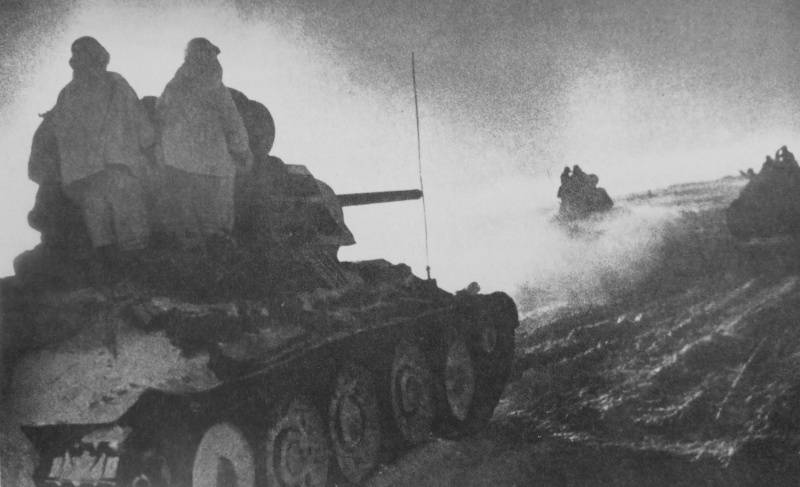
Soviet T-34 tanks with soldiers on armor on the march in the snow-covered steppe during the Middle Aid offensive
Germans
The Wehrmacht High Command attached great importance to retaining defense at the borders of the Don and Chir rivers, continuing to concentrate forces here to unblock Paulus's troops. The Germans were waiting for the strike of the Soviet troops in this direction and were afraid for the defense capability of 8 of the Italian army of General Italo Gariboldi. On the other hand, the attention of the German command was riveted to Stalingrad and the troops of Manstein and Goth, who were to save Paulus's 6 army.
Hitler still hoped that the front line in the Stalingrad sector could restore and maintain the gains of the 1942 campaign of the year. During the meeting in the Wolf's Lair (Wolfshah) 12 of December 1942, he noted: “If we voluntarily give up Stalingrad, then this whole campaign will lose its meaning. To believe that I once again manage to come back is insane. Now, in the winter, we can build reliable cut-off positions with existing forces. The enemy currently has limited transportation options on its existing railway line. Ice is melting, and a transport artery such as the Volga will be at its disposal. He knows what advantage it will give him. Then we are no longer moving forward here, which is why we have no right to leave this place. To achieve this goal, too much blood has been shed. ”
Moreover, the Fuhrer still hoped to defeat the Red Army in the Stalingrad sector. Hitler noted that the German command, if it acted correctly, would be able to carry out bilateral coverage of the grouping of Soviet troops in the Stalingrad area, and then continue the implementation of the previously assigned tasks. “I think,” said Hitler, “it is right to strike first from south to north and break through the ring. Only after that continue the blow to the east, but this, of course, is the music of the future. First you need to find and collect for this force. The decisive, of course, is how the day will pass for the Italians. ” That is, Hitler was aware of the danger in the Italian sector of the front. He feared that a catastrophe would happen here, and it did happen a few days after the meeting in the Wolf Den. But he still overestimated the capabilities of the Wehrmacht and underestimated the increased capabilities and power of the Red Army. He believed that the Stalingrad "bag" gives the German troops even greater opportunities than the Kharkov.
Thus, Hitler did not hurry with the withdrawal of Army Group A from the Caucasus, believing that there was still time to pull new large forces to Stalingrad and turn the struggle on the Russian front in the right direction, retaining the previous successes of the 1942 campaign of the year.
However, the grouping that was in front of the South-West and left wing of the Voronezh fronts was strengthened before the Soviet offensive. Thus, 385-I infantry and 27-I armored German divisions were additionally deployed in the Boguchar region. Wehrmacht command continued to replenish the group of armies "Don".
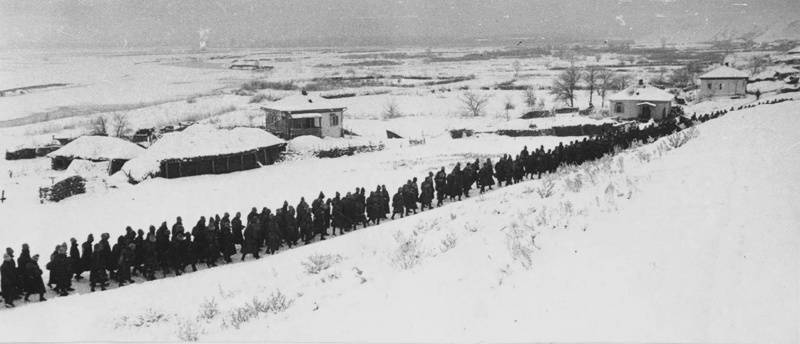
Romanian prisoner of war column near Stalingrad
"Little Saturn"
In the meantime, the command and troops of the Southwestern and left-wing Voronezh fronts were preparing for an offensive in the area of the Middle Don. The concentration of troops and equipment due to the lack of transport and the workload of communications was not completed by the deadline. As a result, the start of the operation scheduled for December 10 was postponed to the 16. In addition, the plan of the operation was substantially adjusted by the Stake due to the delay in eliminating Paulus’s surrounded 6 Army, which could not be crushed on the move and Manstein’s deblocking blow (Operation Winter Thunderstorm).
As a result, taking into account the current situation, it was decided to change the direction of the main attack of the attacking troops. According to the plan of operation "Saturn", it was planned from the Upper Mamon region directly to the south, through Millerovo to Rostov-on-Don, to the rear of the whole Army Group "South". Now the troops were assigned the task of developing an offensive in the southeast direction, to the rear of the deblocking group of Manstein-Goth. That is, the scale of the operation was significantly reduced.
13 December The rate directive addressed to N. N. Voronov, N. F. Vatutina, and F. I. Golikova noted that Operation Saturn was conceived in a favorable military situation, which has now changed. The main attack was directed not to the south, but to the southeast, in order to "take the enemy's lateral-frost group into ticks, walk along its rear lines and eliminate it." The 1-I and 3-I Guards armies of the South-Western Front were to surround and destroy the troops of the 8-I Italian army and the Hollidt task force, and then attack Morozovsk. At the same time, the 6 Army of the Voronezh Front was tasked with striking from the area west of Upper Mamon in the general direction to Kantemirovka to ensure the advance of the strike force of the South-Western Front. The 5 Tank Army was instructed, in cooperation with the 5 Shock Army of the Stalingrad Front, to defeat the enemy in the areas of Lower Chirskaya and Tormosin in order to reliably isolate the surrounded Stalingrad Wehrmacht grouping. The specified plan of operation received the name "Small Saturn".
The forces of the parties
For the operation, the 6-I Army of the Voronezh Front and part of the South-Western Front — the 1-I and 3-I Guards Armies, the 5-I Tank Army, 2-I and 17-I Air Forces. 36 divisions of more than 425 thousand people, more than 5 thousand guns and mortars (without 50-mm mortars and anti-aircraft guns), more than 1 thousand tanks, more than 400 airplanes were involved in the operation by the Red Army.
Our forces in the area from Novaya Kalitva to the Lower Chirskaya (430 km) were opposed by the main forces of the 8 Italian army, the Hollidt task force and the remnants of the 3 Romanian army - around 27 divisions in total, including four tank forces. Enemy troops numbered 459 thousand people, more than 6 thousand guns and mortars, about 600 tanks and about 500 aircraft. The defense of the Germans, Italians and Romanians consisted of two lanes with a total depth of about 25 kilometers, very well equipped and trained in engineering.
Thus, the Soviet troops in comparison with the enemy had slightly fewer people, artillery, inferior to aviationbut had a serious superiority in the number of tanks. However, overwhelming superiority over the enemy was created in the areas of the main attacks of the Soviet troops. In addition, the Italian and Romanian troops had less combat stability than the German. They were worse motivated, armed, and equipped.

German tanks on the railway platform and other property seized at the Kantemirovka station (in the Rossosh-Millerovo section) of the Voronezh Region. Ahead Pz.Kpfw.38 (t) (Czech tank LT vz.38), followed by damaged Pz.Kpfw. IV early modifications
Breakthrough Enemy Defense
The offensive began on December 16. In 8 hours, heavy artillery fire fell on the enemy. However, the hour and a half artillery preparation was held in a thick fog, the shooting was carried out on the squares. And the aircraft could not immediately take part in the destruction of the enemy defense, the planes could not fly up to mid-day. As a result, the enemy fire system was not completely defeated during the preparatory phase. In 9 hour. 30 min. our troops went on the attack.
The troops of the 6 th army of Kharitonov and the 1 th Guards Army of Kuznetsov forced the Don over the ice and the induced crossings, and also advanced from the Osetrovsky bridgehead. The Red Army on a broad front went to the positions of the enemy. In the course of a three-hour fierce battle, the 6 Army's gunners broke into New Kalitva and Derezovka, wedging 2 — 3 km into the enemy defenses. The 1 Guards Army rifle units advanced by midday on its flanks on 1,5 — 2 km. Not having to wait until the infantry breached the enemy’s defensive orders for mobile units to reach operational space, and to speed up the breakthrough of the enemy’s tactical defense zone, the front commanders brought three tank corps into battle: 25, 18 and 17. However, this was done without prior engineering reconnaissance, and the tanks immediately ran into minefields, suffered losses and were forced to halt attacks before making passages in minefields.
In the second half of the day, the fog cleared, and Soviet aircraft began to strike at the battle formations and enemy airfields. German aircraft actively resisted. In the air, there were numerous battles between Soviet and enemy aircraft. The enemy commanders tried to thwart the Soviet offensive, trying to push the Soviet divisions back to their original positions, throwing operational reserves into counterattacks. As a result, by the end of the first day, the successes were small, Soviet troops advanced in the 6 Army’s offensive zone on 4 — 5 km, and in the direction of the main attack of the 1 Guards Army — only on 2 — 3 km. 3-I Guards Army on this day did not achieve success at all.
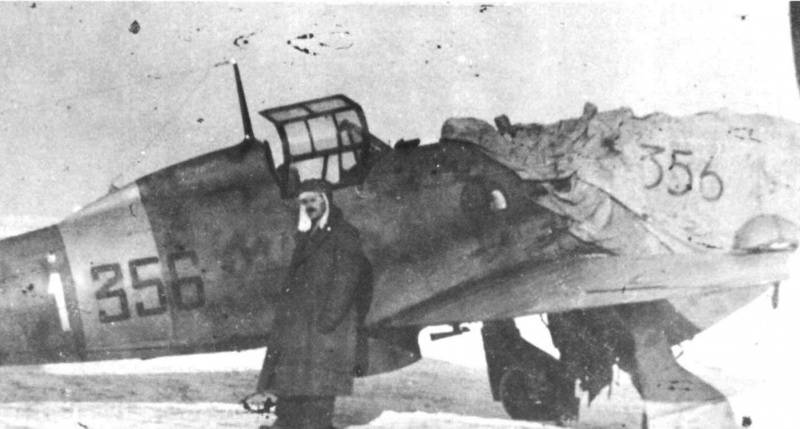
The pilot of the Italian fighter Macchi MC.202 "Folgore" from the 356 squadron (356 Squadriglia) in the steppe on the Eastern Front. 1942 Winter
17 December, the 6 th and 1 th guards armies continued to attack the enemy. Enemy artillery fire, counterattacks, bombing and assault strikes of aircraft sought to disrupt the advancement of our troops. However, rifle divisions now established good cooperation with aircraft and tanks, which ensured the development of initial success. By the end of the day, the troops of the 6 Army broke through the enemy defenses in the areas of Novaya Kalitva and Derezovka, and destroying the remaining centers of resistance of the enemy, deployed a further offensive. The 17 tank corps, which was introduced into the breakthrough, moved forward in the direction of Kantemirovka.
The troops of the 1 Guards Army, advancing from the Lower Mamon, Upper Mamon, Nizhnyaya Gnilusha areas, during the battles of 16 - December 18, broke through the defenses of the 3 Italian Infantry Division and the German 298 Infantry Division, deploying an offensive in the southern and south-east directions. In the offensive zone of this army, the 18, 24, and 25 tank corps were introduced. The troops of 3-th Guards Army, General Lelyushenko, advancing from the line east of Kruzhilin-Bokovskaya, also broke through the enemy defenses. December 18 The 1 Guards Mechanized Corps, together with the 14 rifle corps of this army, captured Astakhov, Konkov, Bokovskaya, and Old Zemtsov settlements. On the left wing of the South-Western Front, General Romanenko’s 5 Panzer Army forces of the 321 Infantry Division and the 5 Mechanized Corps forced the r. Chir and captured the bridgehead length of 15 km along the front and up to 5 km in depth.
Thus, during the three-day stubborn battles, the troops of the South-Western and the left wing of the Voronezh fronts broke through the strong defenses of the enemy in several directions, forced the Don and Bogucharka rivers to fight. The main attack was delivered in the offensive zone of the 1 th Guards and 6 th armies. Here the breakthrough of the enemy’s defense was extended to 60 km along the front, and the advancing troops advanced to 40 km, reaching the southern bank of the r. Bogucharka. 3-I Guards Army broke through the enemy defenses on 20 km along the front and advanced to 15 km in depth. The actions of the ground forces of the fronts were actively supported by our aviation - the 2-I and 17-I air armies of the generals K. N. Smirnov and S. A. Krasovsky.
The Soviet troops defeated the Italian 3 and 9, the German Infantry Divisions 294 and 298, inflicted significant damage on the Italian Infantry Division 52. The defense of the 8 of the Italian army collapsed, all reserves were used on the first day, the command and control of the troops was lost, and a non-stop retreat began.
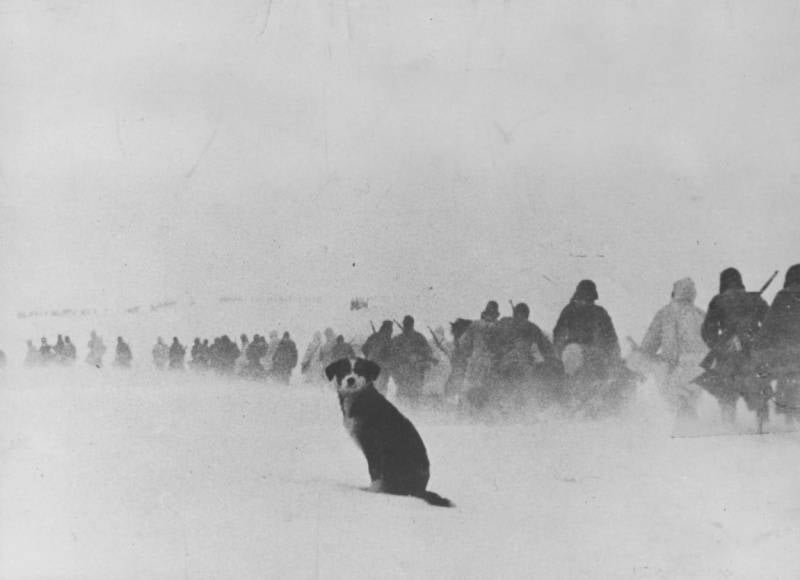
The dog is sitting in the snow on the background of the column of Italian troops, retreating from under Stalingrad
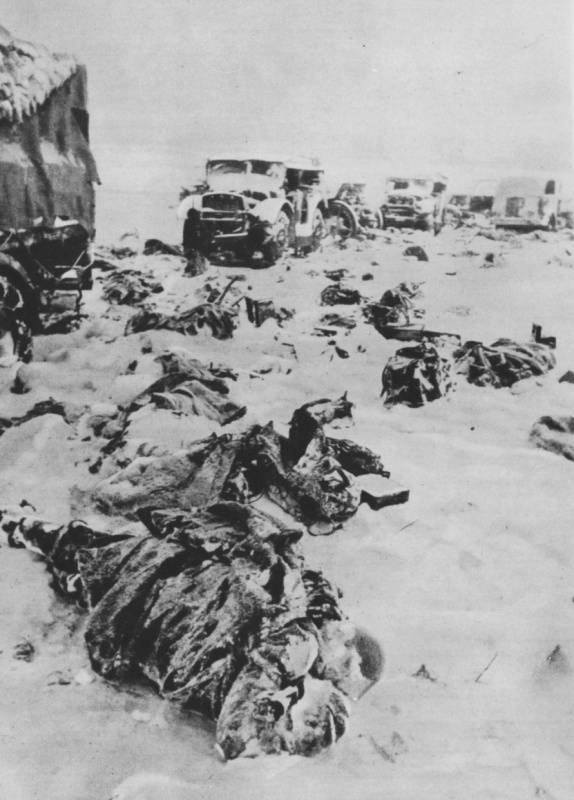
The frozen bodies of Italian soldiers in a broken column of artillery FIAT SPA TL37 on the road near Stalingrad. Background (far right) - Italian truck Fiat 666 NM
Продолжение следует ...
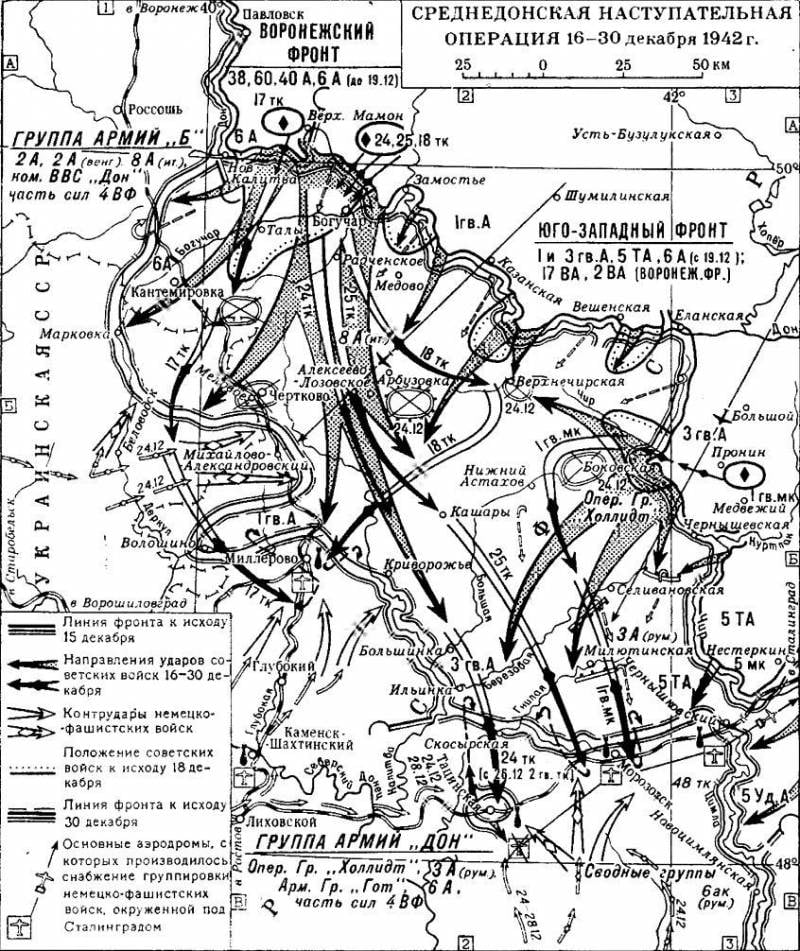
Information